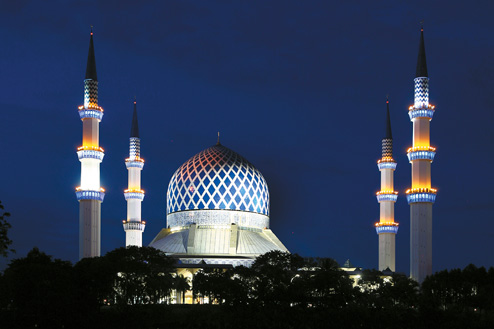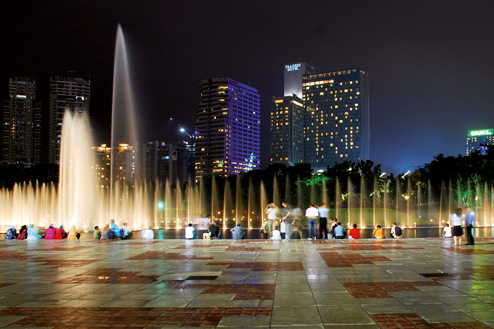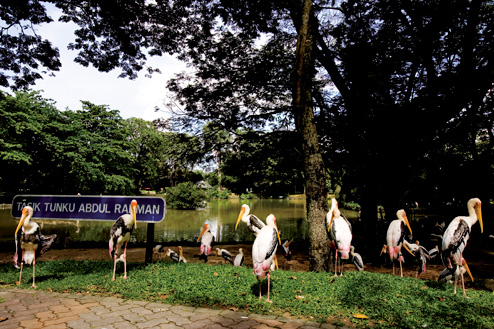Little India
Little India is an area centred on Masjid India on the northwestern side of the Klang River near Jalan Tuanku Abdul Rahman (still known to many by its original name, Jalan Batu). Masjid Jamek is located on the southern side and Jalan Dang Wangi to the north. Jalan Masjid India dissects the area and it is named after the mosque situated just around the corner from Jalan Melayu. This area is the focus for northern Indian Muslims and is one of the oldest parts of the city, being located just a few hundred metres from the confluence of the Gombak and Klang rivers where the city first started. The area is always busy and colourful: when people gather for Friday prayers it’s particularly active and crowded.
Walking the busy streets is the best way to experience the many facets of Indian culture. Many restaurants and shops in the area were originally opened by the Chettiar – an Indian caste who were traditionally moneylenders, merchants and professionals. Shops spill out onto the road and there is an extensive range of goods, from colourful saris to jewellery, brassware, stacks of incense, rolls of fabrics, Muslim prayer items, flowers, and of course, food. There’s sure to be at least one medicine man offering some magical cure for everything from impotence to ingrowing toe nails. While you may not understand the sales pitch, you will definitely enjoy the theatre of it all. There are plenty of budget hotels around here too.
Start exploring the area by alighting from either the Star LRT or Putra LRT, which meet at Masjid Jamek. This is possibly KL’s most beautiful mosque; certainly one of its most serene and compact. It is also the city’s oldest mosque, built in 1909 using red brick and white marble. Like most of these buildings, the architectural inspiration is Mughal and aesthetically the building is without equal. There are various places to photograph the mosque both from within the grounds and also on either side of the southern banks of the Klang River. The mosque is particularly busy at prayer times (especially Friday prayers) and visitors should plan to come here at other times of the day. Only Muslims are allowed in the main prayer hall and shoes must be removed before entering. Modest dress is expected of all visitors.
To reach Little India proper, cross the road and head north along Jalan Melayu, which leads into Jalan Masjid India. Masjid India is situated on the western side of the road just after Wisma Kosas. The original and modest mosque was constructed from timber in 1863 and the present building was erected in 1966. It can accommodate about 3,500 worshippers and is the main Indian Muslim mosque in the city. The three-storey building is representative of a southern Indian mosque, with various onion-shaped domes and arched windows. Non-Muslims are not allowed in but there is enough to admire from the street.
Food is plentiful: from fresh milk to a range of Indian breads, snacks and very sweet cakes. Not all outlets are halal (being Indian Muslim) but some also serve food from other parts of India. This is a good dining area for vegetarians as many Indians do not eat meat, and several restaurants in the area cater to their needs. Some restaurants serve dishes based upon traditional recipes that have never changed. One of the most popular dishes is nasi campur (mixed rice), where diners add their own selection of vegetables and curried meats to a mound of white rice. Curry sauce and poppadoms complete the dish.
For general shopping, visit the popular Semua House. From here, just past the Guobna Building, is the Sri Pathra Kali Amman Temple, open from early morning to late in the evening.
Around the corner from Jalan Bunus, on the main thoroughfare of Jalan Tuanku Abdul Rahman, are two colonial buildings which have significant heritage value and, as such, are protected under the Antiquities Act. The Coliseum Theatre and Coliseum Cafe & Hotel were built in early in the 20th century. The Coliseum resists change and caters to its loyal group of followers who love the old-fashioned ambience and the mostly Hindi and southern Tamil movies screened these days.
The Coliseum Hotel is locked in a time warp but was once the place to stay in KL . Planters used to travel from various parts of the country to ‘live it up’ a little in the big smoke and their hotel of choice was the Coliseum. No doubt they sat in the small bar adjoining the cafe and sipped their gin and tonics. Contemporary visitors drop by today and do exactly the same. While neither the hotel nor cafe would be considered the height of luxury, they don’t come much better in terms of their atmosphere.
There is a night market (pasar malam) along the one-way street off Jalan Tuanku Abdul Rahman every Saturday evening.
Several retail outlets along Jalan Tengu Abdul Rahman include G.S. Gill for sportswear and equipment and the modern Sogo Department Store, which is very popular with local Malaysians. Globe Silk Store, also located on the same street, is one of the country’s oldest department stores, having been around for some 70 years. It sells an extensive array of cloth and clothing. Other shopping places here include Mun Loong Textiles, P Lal Store and Chotimall.
Little India is within easy walking distance of Petaling Street and visitors to the city can explore both at the same time. The best way to get to Little India is to travel by LRT train, whether Putra or Star LRT, as both lines intersect right outside Masjid Jamek. Little India is just a short walk from the station. Other choices are buses and taxis which are easily available. The KL Hop-On Hop-Off City Tour bus makes three stops along Jalan Raja Laut which is just a short walk from Little India.
Walking the busy streets is the best way to experience the many facets of Indian culture. Many restaurants and shops in the area were originally opened by the Chettiar – an Indian caste who were traditionally moneylenders, merchants and professionals. Shops spill out onto the road and there is an extensive range of goods, from colourful saris to jewellery, brassware, stacks of incense, rolls of fabrics, Muslim prayer items, flowers, and of course, food. There’s sure to be at least one medicine man offering some magical cure for everything from impotence to ingrowing toe nails. While you may not understand the sales pitch, you will definitely enjoy the theatre of it all. There are plenty of budget hotels around here too.
Start exploring the area by alighting from either the Star LRT or Putra LRT, which meet at Masjid Jamek. This is possibly KL’s most beautiful mosque; certainly one of its most serene and compact. It is also the city’s oldest mosque, built in 1909 using red brick and white marble. Like most of these buildings, the architectural inspiration is Mughal and aesthetically the building is without equal. There are various places to photograph the mosque both from within the grounds and also on either side of the southern banks of the Klang River. The mosque is particularly busy at prayer times (especially Friday prayers) and visitors should plan to come here at other times of the day. Only Muslims are allowed in the main prayer hall and shoes must be removed before entering. Modest dress is expected of all visitors.
To reach Little India proper, cross the road and head north along Jalan Melayu, which leads into Jalan Masjid India. Masjid India is situated on the western side of the road just after Wisma Kosas. The original and modest mosque was constructed from timber in 1863 and the present building was erected in 1966. It can accommodate about 3,500 worshippers and is the main Indian Muslim mosque in the city. The three-storey building is representative of a southern Indian mosque, with various onion-shaped domes and arched windows. Non-Muslims are not allowed in but there is enough to admire from the street.
Food is plentiful: from fresh milk to a range of Indian breads, snacks and very sweet cakes. Not all outlets are halal (being Indian Muslim) but some also serve food from other parts of India. This is a good dining area for vegetarians as many Indians do not eat meat, and several restaurants in the area cater to their needs. Some restaurants serve dishes based upon traditional recipes that have never changed. One of the most popular dishes is nasi campur (mixed rice), where diners add their own selection of vegetables and curried meats to a mound of white rice. Curry sauce and poppadoms complete the dish.
For general shopping, visit the popular Semua House. From here, just past the Guobna Building, is the Sri Pathra Kali Amman Temple, open from early morning to late in the evening.
Around the corner from Jalan Bunus, on the main thoroughfare of Jalan Tuanku Abdul Rahman, are two colonial buildings which have significant heritage value and, as such, are protected under the Antiquities Act. The Coliseum Theatre and Coliseum Cafe & Hotel were built in early in the 20th century. The Coliseum resists change and caters to its loyal group of followers who love the old-fashioned ambience and the mostly Hindi and southern Tamil movies screened these days.
The Coliseum Hotel is locked in a time warp but was once the place to stay in KL . Planters used to travel from various parts of the country to ‘live it up’ a little in the big smoke and their hotel of choice was the Coliseum. No doubt they sat in the small bar adjoining the cafe and sipped their gin and tonics. Contemporary visitors drop by today and do exactly the same. While neither the hotel nor cafe would be considered the height of luxury, they don’t come much better in terms of their atmosphere.
There is a night market (pasar malam) along the one-way street off Jalan Tuanku Abdul Rahman every Saturday evening.
Several retail outlets along Jalan Tengu Abdul Rahman include G.S. Gill for sportswear and equipment and the modern Sogo Department Store, which is very popular with local Malaysians. Globe Silk Store, also located on the same street, is one of the country’s oldest department stores, having been around for some 70 years. It sells an extensive array of cloth and clothing. Other shopping places here include Mun Loong Textiles, P Lal Store and Chotimall.
Little India is within easy walking distance of Petaling Street and visitors to the city can explore both at the same time. The best way to get to Little India is to travel by LRT train, whether Putra or Star LRT, as both lines intersect right outside Masjid Jamek. Little India is just a short walk from the station. Other choices are buses and taxis which are easily available. The KL Hop-On Hop-Off City Tour bus makes three stops along Jalan Raja Laut which is just a short walk from Little India.













